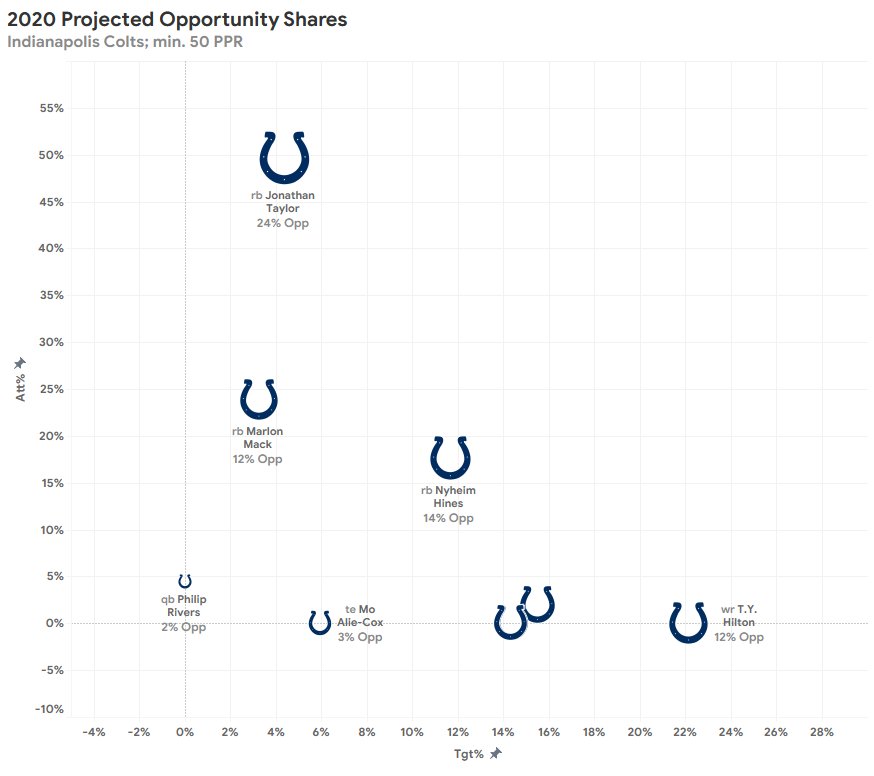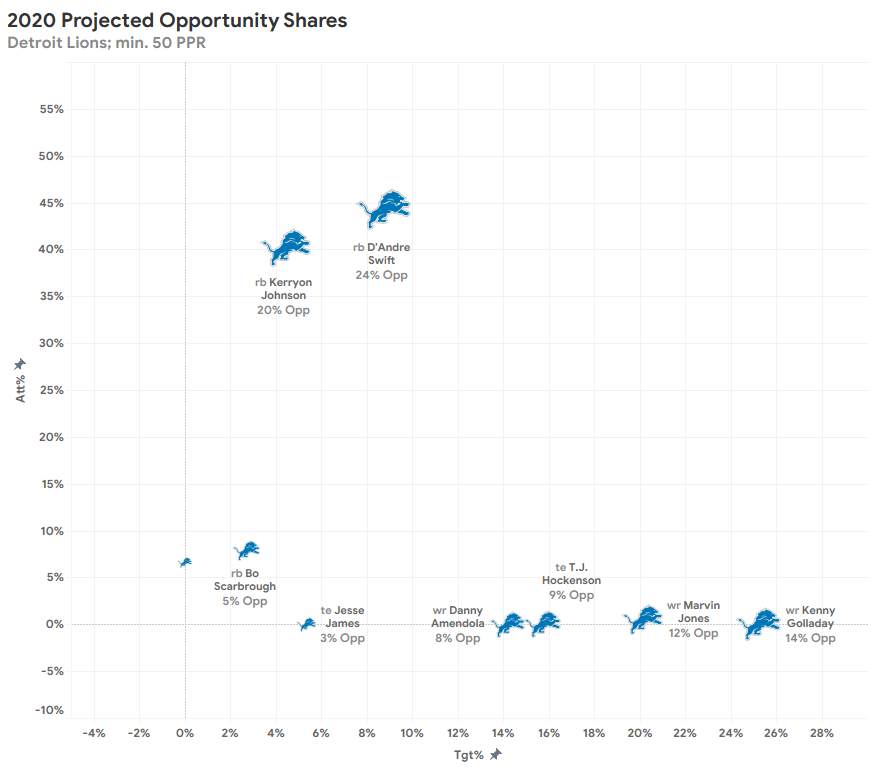Antonio Losada looks at NFL backfields expected to use an RBBC, making those running backs bad fantasy football draft assets for the 2020 season.
In fantasy football, volume is the key to rostering and fielding a winning team. While everything boils down to that concept, seeking volume calls for looking deeper than just the name and reputation of players. Put a great running back in an RBBC backfield and his volume--and thus his fantasy outcome--will drop without question. The touches and opportunities will go down and with them the chances at scoring fantasy points.
With that in mind, it makes sense to pursue backfields with clear and very well-defined roles. Even if the players in those backfields are not top-tier options they will get all of the opportunities they can handle, which will ultimately benefit them. Those players might not be that good, but they will compensate for it just on pure volume. And the exact opposite is also true: great ballcarriers can rack up points even on low volume, separating themselves from the pack.
Today, I will explore some backfields that enter the 2020 season with doubts at the position and are expected to run an RBBC, making their players bad draft picks for the upcoming year. Let's get to it!
Be sure to check all of our fantasy football rankings for 2025:- 2025 fantasy football rankings (redraft)
- Dynasty fantasy football rankings
- 2025 NFL rookie fantasy football rankings
- Best ball fantasy football rankings
- Quarterback fantasy football rankings
- Running back fantasy football rankings
- Wide receiver fantasy football rankings
- Tight end fantasy football rankings
Ke'Shawn Vaughn, Ronald Jones II
Tampa Bay Buccaneers
If only were tailbacks the ones bringing me a headache from Tampa Bay... Not only do the Bucs feature two virtually equal running backs, but they also are bringing to the team QB Tom Brady and best-friend TE Rob Gronkowski to the team to bulk an already-in-place receiver corps that consists of Mike Evans and Chris Godwin. This offense, simply put, can't be more stacked.
Focusing on the backfield of Jones and Vaughn, though, it's just too risky to go with either of them for the 2020 season. Ronald Jones is projected by PFF to reach the highest rushing attempt share among RB2 league-wide with a staggering 41.5% of them. The problem is he will also be losing 43.5% to rookie Ke'Shawn Vaughn. On the receiving side of things, neither Jones (1.1% target share with 6) nor Vaughn (5.9% with 32) projects to be relevant.
Tampa doesn't need its tailbacks to produce through the air with such talented players as Evans, Gronkowski, and Godwin (and even O.J. Howard) as their primary receiving weapons. That makes both Vaughn's and Jones' projected total opportunity shares of 21.1% and 17.4% pale when compared to those of the average no. 1 (29.4%) RB of the rest of the NFL teams.
Jordan Howard, Matt Breida
Miami Dolphins
The Dolphins will have a brand new backfield in 2020, but I'm not entirely sure if they know what they'll do with it come Week 1. Both Jordan Howard and Matt Breida project to log at least 18% of the team's total opportunities between rushing and receiving over the rest of the team's players, but that 22% of Howard is ridiculously low for an RB1 in the NFL (remember: the average RB1 projects to get 29.2% of opportunities).
Howard ranks 30th among RB1 in 2020 opportunity share projections (only above Ke'Shawn Vaughn and Derrius Guice), and Matt Breida ranks as the 38th-highest RB but is behind WR1 Davante Adams in opportunity share (as wide receivers are not expected to carry the ball, all of their shares come from targets, so to fall behind a wide receiver while being a running back is a no-go for RB1).
There will definitely be a battle for that no. 1 spot in Miami's backfield and the most probable outcome is an even share of opportunities between Howard and Breida that will see both lose fantasy points if only because of the touches and targets they'll miss in favor of the other.
The numbers are very even: Howard projects to get 161 carries and 23 targets to Breida's 119 and 35. They are expected to reach 120.6 and 118.0 PPR respectively. You can 1) draft one of those two and expect them to finish the year on those even terms, or 2) avoid them and not risk one of the two to clearly beat the other, leaving the latter in the dust and (if you're the owner of that last one) you too.
Marlon Mack, Jonathan Taylor, Nyheim Hines
Indianapolis Colts
I love Indianapolis' backfield more than any other and can't wait to watch it in action. That been said, I want no part of it in my fantasy teams. Either if you believe the projections for Taylor as the RB1 of the Colts or if you flip his projections with those of Mack, if you like veterans more, you still have to factor Nyheim Hines in the equation. There is so much going on here.
First of all, it isn't clear if Mack or Taylor will be the actual no. 1 rusher of the team. Taylor is a rookie with massive upside, but Mack is a proven veteran that should at least be given the benefit of the doubt during the first few weeks. That is already going to hurt you if you have any of those two RBs in your roster because they'll split opportunities. Then, there is the presence of Hines.
Hines projects as the fifth most-targeted player of the Colts, all-positions considered. The coaches have been saying that he will get all of the targets he can handle from the backfield, which means no carries/targets for both Taylor and Mack. I think the 199 rushing attempts PFF is giving to Taylor are too many, and that he will surrender some to Mack. If that is the case, we might watch a backfield in which three players get between 14% and 20% of the team's opportunities, which would be too much of a share to make any of the three RBs a league-winning asset.
D'Andre Swift, Kerryon Johnson, Bo Scarbrough
Detroit Lions
I know, you might not consider Bo Scarbrough a real threat to both Swift and Johnson, but you have to still include him in what is starting to look as a messy backfield in Detroit. Swift is a rookie with upside, and Johnson can be considered a veteran already. This resembles the situation in Indianapolis, only there is not such a clear threat on the passing game as Nyheim Hines is there.
Fantasy GMs (and PFF projections) are currently giving Swift the edge by drafting him at more expensive ADPs and also better projections. Even with that, both rushers are really close to everything. Swift projects to get 177 rushing attempts to Johnson's 161, and they're 2:1 target projections with 47 (8.7% share) and 24 (4.4%) respectively.
That expected split of duties translates into both player's PPR projections for 2020: Swift is currently the RB24 for PFF (179.2 PPR) and Johnson would finish as RB38 (134.5). Just so you see how low in the top-tier (no. 1 rushers) and high in the second-tier (no. 2 rushers) they are: Swift would be 9th-worst RB1 in the league among all 32 "starting" rushers, while Johnson would be the 7th-best RB2.
They will lose a lot of points between themselves, and while Bo Scarbrough doesn't profile as a real threat, in the case of any injury popping during the season he could become a menace to whoever stays healthy (you know what happened last season when he came out of nowhere).
More Fantasy Football Analysis
 RADIO
RADIO






























